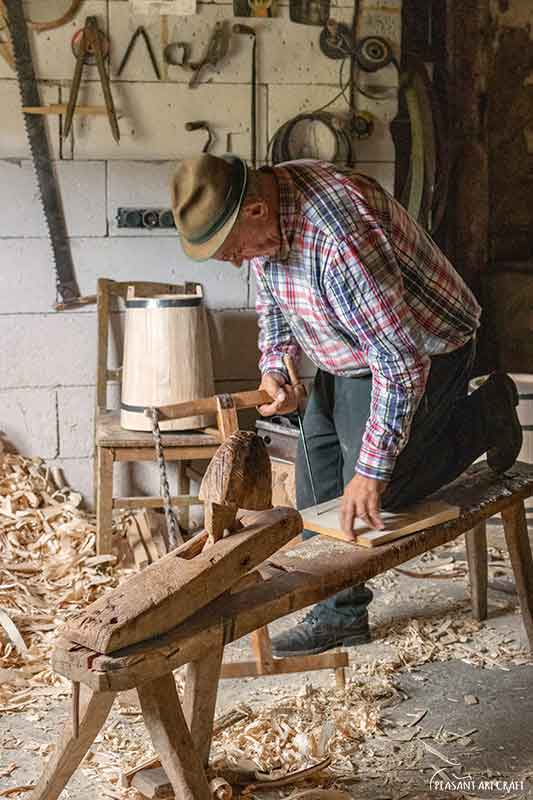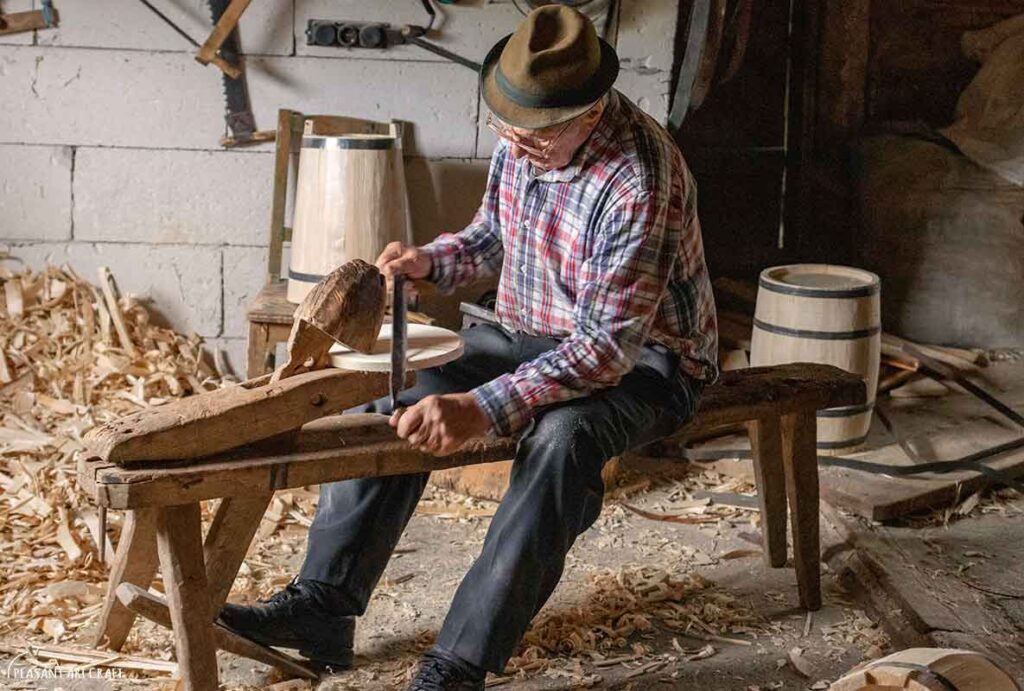
This article features affiliate links, meaning we’ll earn a small commission if you purchase through these links. Please read our Privacy Policy for more details.
Iosif Alexandrovici, the last cooper standing in Plesa village, once famed for its barrel makers, demonstrates how to make a wooden barrel.
Perfectly placed on a picturesque hill in Suceava County, Pleșa seems like a fairytale village. From its idyllic landscapes, with yellow rape on mountain slopes, to the way in which the quaint country cottages cascade down the hillside, this village will charm every visitor that might come here, to either relax in the lap of nature, or hike up the hill to visit the ancient faces carved into the cliff, or just wander about, talking to random locals, because the Polish community that lives here has an interesting, one-of-a-kind history. For centuries, nearly everyone who lived in this village was, in one way or another, part of the cooper trade. With the help of their sons and daughters, who learned from a fragile age how to make a wooden barrel, the men would build barrels as tall as 7 ft, pails, tankards, butter churns, tubs, and pickle jars, while the women sold them on the market.


Of them all, Iosif Alexandrovici is the only person in the village still working the ancient craft using traditional methods.
“At 15 years old I was already making barrels. My siblings were in charge of skidding logs, and I was helping my father. We would travel by carriage a day and a night all the way to Botosani. We would leave Tuesday morning and arrive at the market in Botosani on Wednesday morning. We had large barrels, up to 100-200 kg all loaded at a time, 40-50 pieces stacked upon each other to fit them all,” remembers Mr. Alexandrovici Iosif.

In Romania, barrels are vital for pickle-making and cheese storage. On sheepfolds, for instance, barrels are used to store the milk and cheese, as well as to produce sour milk and butter. In the pickle town of Milisauti, oak barrels as tall as 7 ft are in high demand, each one housing up to 6000 pounds of pickles.


For centuries, wooden barrels have been used for storage and transportation and to this day are used for the fermentation of pickles and cabbage, barrel-cured pickles being one of the oldest ways to preserve traditional flavors.
“I can make anything,” he says cheerfully. “Jars, tubs, barrels of any kind. So far it’s been the season of milk barrels, which are used to make cheese on sheepfolds. In the fall, when demand for barrels tends to be greatest, I make barrels for cabbage and pickles. Winter is the time to get wood supply and do different repair works,” he continues.


His herd of cows grazing happily on the hill to the music played by multiple cattle bells ringing simultaneously. The garden is in bloom, still wet from the spring rain that fell, creating crispy, fresh air.
In the yard, two wooden barrels air-drying, and even more wood shingles are laid against the ledge. Tapping noises are coming from the cooperage at the end of the yard. The cooper is hard at work very early in the morning.
Affiliate Links
BARREL HOOP NAILS (GALVANIZED STEEL) Nail Hardware to Hold up Metal Hoops on Wine or Whiskey Barrels“This craft was inherited from my father when I was a child. I had worked as a cooper before I got a job in the army. I went into the service, then I worked as a driver until 1994. After retirement, I came back to barrel making, so I am working harder than before.”
The Barrel Making Process and Tools of The Trade

In his workshop, a fresh-cut scent of wood fills the air. Coils of wood shavings cover the floor. Tiny particles of wood dust float in the sunlight shining through the little window. Upon the wall, the cooper’s tools of the trade are neatly displayed: draw knives, saws, compasses, groovier, hoop drivers, and hammers.


Making The Staves With Draw Knives
“I am making a pickle jar,” he says, and he prepares for making the staves.
In barrel making, there are various construction stages. The starting point in barrel construction is making the staves. They are chopped outdoors with an axe and mallet, then they are carefully shaped with two types of draw knives.
“The first tools that I use are two draw knives. The flat draw knife is used to cut the curvature on the exterior of the staves, and the hollowing knife is used for hollowing out the interior of the staves.”

Affiliate Links
Robust drawing knife for removing wooden beamsYou can tell his work experience by how he shapes the staves, hollowing out the curvature on the interior of the staves with a rounded draw knife, and cutting on the exterior of the staves with a flat draw knife. Then he uses a jointer plane. He knows the exact shape of each stave, just stopping to check the curvature with a maquette every now and again.
Building Hoops and Constructing The Barrel

All the staves are then brought together with the use of a pair of temporary hoops. This stage is when the exact shaping of the staves really comes into effect, because the barrel must be watertight, without any gluing of the staves. After construction is complete, the temporary hoops are removed and replaced with permanent hoops made-to-measure and splayed by the barrel maker. The new hoops are knocked into position with a hoop driver and a hammer.

Heading the Barrel
To cut the bottom of the barrel, the cooper takes a compass and starts to measure by trial and error, counting six turns.
With a groovier tool what’s called a croze he cuts a groove in the inside ends of the barrel, by setting that croze inside there and rocking it around. Now the bottom of the barrel is beveled and shaped to fit into the groove, then it is knocked into the groove. The lid is crafted in the same manner as the bottom, measured with a compass, sawed, and shaped on a drawbench. To finish, the outside of the barrel is planed smooth with a flat draw knife and sanded.
How to Make a Wooden Barrel – VIDEO
This video condenses the meticulous multi-step process that is required to make a wooden jar and a barrel for storing pickles and cheese. The video shows each of the many steps, starting with chopping staves and ending with constructing and finishing the jar.
Location: Village of Plesa, Suceava County, Romania
Similar Articles
Woodworking Craftsman Builds Rustic Stool With Hand Tools










Leave a Comment